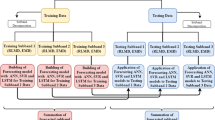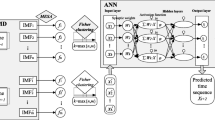Abstract
In this study, a nonparametric technique to set up a river stage forecasting model based on empirical mode decomposition (EMD) is presented. The approach is based on the use of the EMD and artificial neural networks (ANN) to forecast next month’s monthly streamflows. The proposed approach is applied to a real case study. The data from station on the Kizilirmak River in Turkey was used. The mean square errors (MSE), mean absolute errors (MAE) and correlation coefficient (R) statistics were used for evaluating the accuracy of the EMD-ANN model. The accuracy of the EMD-ANN model was then compared to the artificial neural networks (ANN) model. The results showed that EMD-ANN approach performed better than the ANN in predicting stream flows. The most accurate EMD-ANN model had MSE = 0.0132, MAE = 0.0883 and R = 0.8012 statistics, respectively.






Similar content being viewed by others
References
Alvisi S, Franchini M (2011) Fuzzy neural networks for water level and discharge forecasting with uncertainty. Environ Model Softw 26:523–537
D.R Brillinger, and P.R. Krishnaiah, “Time Series in the Frequency Domain”, Amsterdam: North Holland, 1983.
Ch S, Anand N, Panigrahi BK, Mathur S (2013) Streamflow forecasting by SVM with quantum behaved particle swarm optimization. Neurocomputing 101:18–23
Chauhan S, Shrivastava RK (2009) Performance evaluation of reference evapotranspiration estimation using climate based methods and artificial neural networks. Water Resour Manag 23(5):825–837
Chen C, Lai MC, Yeh CC (2012) Forecasting tourism demand based on empirical mode decomposition and neural network. Knowl-Based Syst 26:281–287
Cheng JS, Yu DJ, Yang Y (2004) Energy operator demodulating approach based on EMD and its application in mechanical fault diagnosis. Chin J Mech Eng 40(8):115–118
Citakoglu H, Cobaner M, Haktanir T, Kisi O (2014) Estimation of long-term monthly reference evapotranspiration in Turkey. Water Resour Manag 28:99–113
Guo J, Zhou J, Qin H, Zou Q, Li Q (2011) Monthly streamflow forecasting based on improved support vector machine model. Expert Syst Appl 38:13073–13081
Haykin S (1999) “Neural network: a comprehensive foundation”. Prentice-Hall, Englewood Cliffs, NJ
Hipel KW, McLeod AI (1994) Time Series Modelling of Water Resources and Environmental Systems. Elsevier, Amsterdam
N.E. Huang, Z. Shen, S.R. Long, M.C. Wu, H.H. Shih, Q. Zheng, “The empirical mode decomposition and the Hilbert spectrum for nonlinear and nonstationary time series analysis”, in: Proceedings of the royal society of London series a–mathematical physical and engineering sciences, series A, 454 903–995, 1998
Huang NE, Shen Z, Long SR (1999) A new view of nonlinear water waves: the Hilbert spectrum. Annu Rev Fluid Mech 31:417–457
Huang Y, Schmitt FG, Lu Z, Liu Y (2009a) Analysis of daily river flow fluctuations using empirical mode decomposition and arbitrary order Hilbert spectral analysis. J Hydrol 373:103–111
Huang FG, Schmitt Z, Lu Y, Liu (2009b) Analysis of daily river flow fluctuations using empirical mode decomposition and arbitrary order Hilbert spectral analysis. J Hydrol 373:103–111
Katambara Z, Ndiritu J (2009) A fuzzy inference system for modelling streamflow: Case of Letaba River, South Africa. Phys Chem Earth 34:688–700
Kim S, Shiri J, Kisi O (2012) Pan evaporation modeling using neural computing approach for different climatic zones. Water Resour Manag 26(11):3231–3249
Kim S, Shiri J, Kisi O, Singh VP (2013) Estimating daily pan evaporation using different data-driven methods and lag-time patterns. Water Resour Manag 27(7):2267–2286
Kim S, Singh VP, Seo Y, Kim HS (2014) Modeling nonlinear monthly evapotranspiration using soft computing and data reconstruction techniques. Water Resour Manag 28(1):185–206
Kisi O (2004a) Multi-layer perceptrons with Levenberg-Marquardt training algorithm for suspended sediment concentration prediction and estimation. Hydrol Sci J 49(6):1025–1040
Kisi O (2004b) River flow modeling using artificial neural networks. J Hydrol Eng 9(1):60–63
Kisi O (2008) River flow forecasting and estimation using different artificial neural network techniques. Hydrol Res 39(1):27–40
Kisi O, Cimen M (2011) A wavelet-support vector machine conjunction model for monthly streamflow forecasting. J Hydrol 399:132–140
S. Kumar, “Neural Networks: A Classroom Approach”, McGraw-Hill Education, 2005
Lin CS, Chiu SH, Lin TY (2012) Empirical mode decomposition–based least squares support vector regression for foreign exchange rate forecasting. Econ Model 29:2583–2590
D. Machiwal, M. K. Jha, “Hydrologic Time Series Analysis: Theory and Practice”, Springer, 2012
Mohammad A (2013) Monthly river flow forecasting using artificial neural network and support vector regression models coupled with wavelet transform. Compt Rendus Geosci 54:1–8
Napolitano G, Serinaldi F, See L (2011) Impact of EMD decomposition and random initialization of weights in ANN hindcasting of daily stream flow series: An empirical examination. J Hydrol 406:199–214
Partal T, Kisi O (2007) Wavelet and neuro-fuzzy conjunction model for precipitation forecasting. J Hydrol 342:199–212
Y.F. Sang, Z. Wanga, C. Liu, “Period identification in hydrologic time series using empirical mode decomposition and maximum entropy spectral analysis”, Journal of Hydrology 424–425, pp.154–164, 2012
Valipour M, Banihabib ME, Behbahani SMR (2013) Comparison of the ARMA, ARIMA, and the autoregressive artificial neural network models in forecasting the monthly inflow of Dez dam reservoir. J Hydrol 476:433–441
H.T. Vincent, S.-L.J. Hu, Z. Hou, Damage detection using empirical mode decomposition method and a comparison with wavelet analysis, in: Proceedings of the second international workshop on structural health monitoring, Stanford pp. 891–900, 1999
Wang W, Van Gelder P (2006) JK. Vrijling, J. Ma, “Forecasting daily streamflow using hybrid ANN models”. J Hydrol 324:383–399
Wei Y, Chen MC (2012) Forecasting the short-term metro passenger flow with empirical mode decomposition and neural networks. Transp Res C 21:148–162
Yegnanarayana, “Artificial Neural Networks”, Prentice Hall of India, 2006
Author information
Authors and Affiliations
Corresponding author
Rights and permissions
About this article
Cite this article
Kisi, O., Latifoğlu, L. & Latifoğlu, F. Investigation of Empirical Mode Decomposition in Forecasting of Hydrological Time Series. Water Resour Manage 28, 4045–4057 (2014). https://doi.org/10.1007/s11269-014-0726-8
Received:
Accepted:
Published:
Issue Date:
DOI: https://doi.org/10.1007/s11269-014-0726-8




